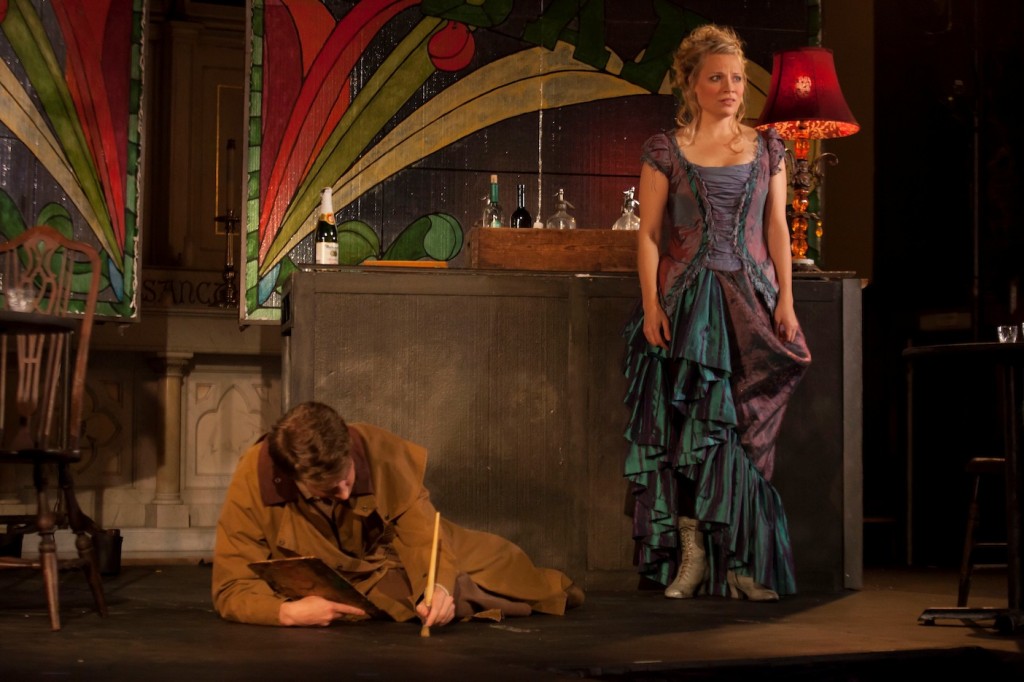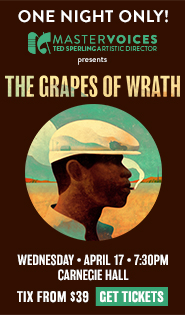Chelsea Opera makes a worthy case for Mollicone double bill

Molly Mustonen and Benjamin Robinson in Henry Mollicone’s “The Face on the Barroom Floor.” Photo: Robert J. Saferstein
A week of worthwhile performances from some of the notable, small opera companies in New York came to a point Friday with opening night for Chelsea Opera. In St. Peter’s Church on West 20th street, the company produced a double-bill of two one act operas from composer Henry Mollicone, The Face on the Barroom Floor and Emperor Norton.
Mollicone, who was on hand to conduct the music from the piano, is one of a group of composers on the West Coast who are, if not exactly a school, a group of like-minded individuals, perhaps drawn to the lack of received wisdom about the European classical tradition that historically hangs heavy on the East Coast. Like Conrad Susa or David Conte, Mollicone writes tuneful music that values the clear expression of an intelligent, meaningful and complex subject. That’s a recipe for quality drama.
The two operas are some of his earliest works in the form: Barroom Floor is his first mature opera, written in 1978, and Norton was composed three years later. These are chamber works for a small handful of singers and accompaniment of piano, flute and cello for Barroom Floor, and piano, violin and cello for Norton. John S. Bowman, who was also in attendance, wrote the librettos for each.
The scope of these pieces makes them eminently affordable for a small company, but there was nothing cheap in Chelsea Opera’s staging. Anna Yates’ sets were minimal in scope but full of details, and Lynne Hayden-Findlay’s costumes were almost extravagant. Hayden-Findlay also directed, and kept the action lively on the small stage.
Face on the Barroom Floor is developed out of poem of nearly the same title, written, most likely, by Hugh Antoine D’Arcy. In the story, Isabelle, a local opera chorister, and her boyfriend Larry, stop in the Teller House bar, in Central City, CO, where there is the face of a woman painted on the floor. Bartender Tom explains that the face was painted long ago by an artist who hadn’t the money to pay for his drinks. The painting was his payment, and he explained that the face was that of his first love, who happened to be the current lover of the bartender. The two men fought, and the girl was killed by accident. Back in contemporary time, the bartender reveals that he used to be the lover of the chorister, and the cycle of tragedy repeats.
The opera tells the two tales, the music parallels and cycles through time. The score starts with blues and boogie-woogie and moves into a neo-romantic idiom, with notable injections of Ives-ian mystic chords of memory.
The opera is just a little too compact. The characters almost immediately down-shift and accelerate, and the dense scoring feels the need to push everything along. With the exciting and powerful singing from soprano Molly Mustonen, tenor Benjamin Robinson as Larry, and baritone John E. Callison as Tom, there’s little space for the weight of the proceedings to sink in.
There is a lovely flute melody in the score, though, and that was a bridge to Emperor Norton, which is a strong, involving opera, composed with craft and a great clarity of purpose. This is also a ghost story, based on the quasi-legendary 19th century San Francisco street character Emperor Norton, the self-proclaimed Emperor of the United States.
The premise is that in 1930s San Francisco, two actors, Diana (soprano Rosa Betancourt) and Michael (tenor David Gordon), show up for auditions arranged over the phone with a mysterious man. Backstage, they meet playwright Marla (soprano Vira Slywotzky), who is working on a play about Norton. Then the mysterious voice appears, in the guise of a man offering impassioned insight and details into Norton’s life. This is, of course, Norton’s ghost, accompanied by atmospheric fog.
Working with the other characters, Norton (sung and played with tremendous charisma and sympathy by bass Justin Ryan), brings them back in time to retell events in his life. These are evocative scenes that shape Norton as a compelling character.
The music is simple, more direct, and more powerful than Barroom Floor with notable shape and direction. Rather than underline every word and action, it flows along with the singers, adding lyricism to the drama. The main feature is a finely crafted melody that rises and falls, and Mollicone repeats it throughout as a kind of emotional and musical bookmark, moving it around the registers of piano, violin and cello. One starts to expect it and then experiences great satisfaction when the tune returns.
While the climax may be over the top for some tastes, this is a potent one-act opera, with terrific performances. In the end Norton and Marli find companionship in each other, and head into the past together.
Chelsea Opera repeats both operas 4 p.m. Saturday. chelseaopera.org



